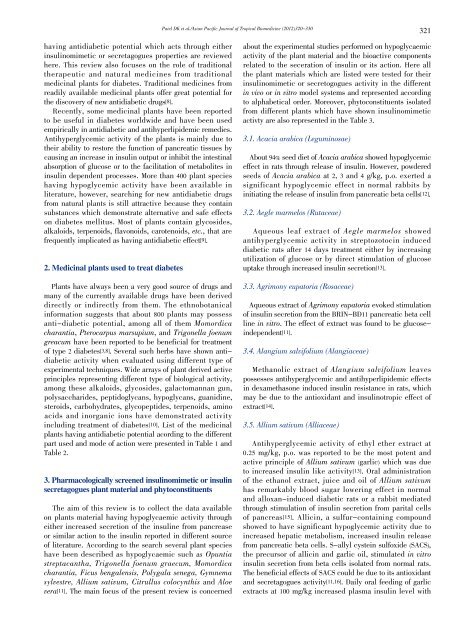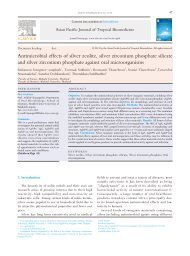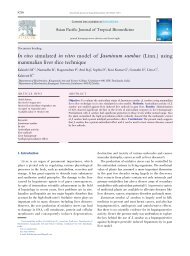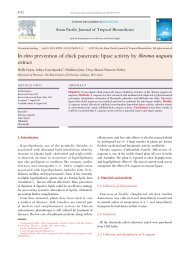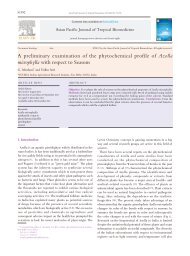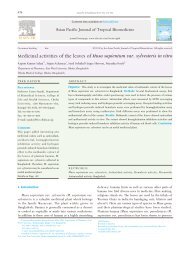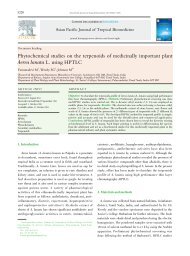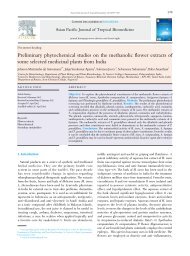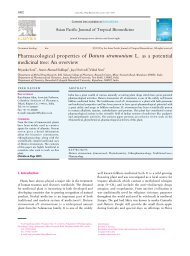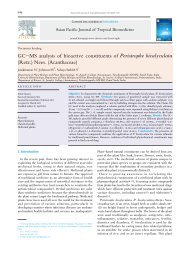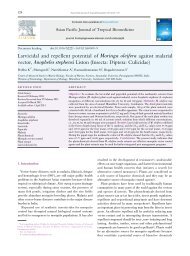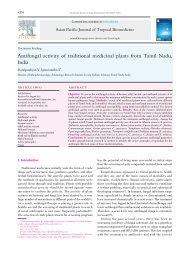An overview on antidiabetic medicinal plants having ... - Apjtb.com
An overview on antidiabetic medicinal plants having ... - Apjtb.com
An overview on antidiabetic medicinal plants having ... - Apjtb.com
Create successful ePaper yourself
Turn your PDF publications into a flip-book with our unique Google optimized e-Paper software.
Patel DK et al./Asian Pacific Journal of Tropical Biomedicine (2012)320-330<br />
321<br />
<strong>having</strong> <strong>antidiabetic</strong> potential which acts through either<br />
insulinomimetic or secretagogues properties are reviewed<br />
here. This review also focuses <strong>on</strong> the role of traditi<strong>on</strong>al<br />
therapeutic and natural medicines from traditi<strong>on</strong>al<br />
<strong>medicinal</strong> <strong>plants</strong> for diabetes. Traditi<strong>on</strong>al medicines from<br />
readily available <strong>medicinal</strong> <strong>plants</strong> offer great potential for<br />
the discovery of new <strong>antidiabetic</strong> drugs[8].<br />
Recently, some <strong>medicinal</strong> <strong>plants</strong> have been reported<br />
to be useful in diabetes worldwide and have been used<br />
empirically in <strong>antidiabetic</strong> and antihyperlipidemic remedies.<br />
<str<strong>on</strong>g>An</str<strong>on</strong>g>tihyperglycemic activity of the <strong>plants</strong> is mainly due to<br />
their ability to restore the functi<strong>on</strong> of pancreatic tissues by<br />
causing an increase in insulin output or inhibit the intestinal<br />
absorpti<strong>on</strong> of glucose or to the facilitati<strong>on</strong> of metabolites in<br />
insulin dependent processes. More than 400 plant species<br />
<strong>having</strong> hypoglycemic activity have been available in<br />
literature, however, searching for new <strong>antidiabetic</strong> drugs<br />
from natural <strong>plants</strong> is still attractive because they c<strong>on</strong>tain<br />
substances which dem<strong>on</strong>strate alternative and safe effects<br />
<strong>on</strong> diabetes mellitus. Most of <strong>plants</strong> c<strong>on</strong>tain glycosides,<br />
alkaloids, terpenoids, flav<strong>on</strong>oids, carotenoids, etc., that are<br />
frequently implicated as <strong>having</strong> <strong>antidiabetic</strong> effect[9].<br />
2. Medicinal <strong>plants</strong> used to treat diabetes<br />
Plants have always been a very good source of drugs and<br />
many of the currently available drugs have been derived<br />
directly or indirectly from them. The ethnobotanical<br />
informati<strong>on</strong> suggests that about 800 <strong>plants</strong> may possess<br />
anti-diabetic potential, am<strong>on</strong>g all of them Momordica<br />
charantia, Pterocarpus marsupium, and Trig<strong>on</strong>ella foenum<br />
greacum have been reported to be beneficial for treatment<br />
of type 2 diabetes[3,8]. Several such herbs have shown <strong>antidiabetic</strong><br />
activity when evaluated using different type of<br />
experimental techniques. Wide arrays of plant derived active<br />
principles representing different type of biological activity,<br />
am<strong>on</strong>g these alkaloids, glycosides, galactomannan gun,<br />
polysaccharides, peptidoglycans, hypoglycans, guanidine,<br />
steroids, carbohydrates, glycopeptides, terpenoids, amino<br />
acids and inorganic i<strong>on</strong>s have dem<strong>on</strong>strated activity<br />
including treatment of diabetes[10]. List of the <strong>medicinal</strong><br />
<strong>plants</strong> <strong>having</strong> <strong>antidiabetic</strong> potential acording to the different<br />
part used and mode of acti<strong>on</strong> were presented in Table 1 and<br />
Table 2.<br />
3. Pharmacologically screened insulinomimetic or insulin<br />
secretagogues plant material and phytoc<strong>on</strong>stituents<br />
The aim of this review is to collect the data available<br />
<strong>on</strong> <strong>plants</strong> material <strong>having</strong> hypoglycaemic activity through<br />
either increased secreti<strong>on</strong> of the insuline from pancrease<br />
or similar acti<strong>on</strong> to the insulin reported in different source<br />
of literature. According to the search several plant species<br />
have been described as hypoglycaemic such as Opuntia<br />
streptacantha, Trig<strong>on</strong>ella foenum graecum, Momordica<br />
charantia, Ficus bengalensis, Polygala senega, Gymnema<br />
sylvestre, Allium sativum, Citrullus colocynthis and Aloe<br />
vera[11]. The main focus of the present review is c<strong>on</strong>cerned<br />
about the experimental studies performed <strong>on</strong> hypoglycaemic<br />
activity of the plant material and the bioactive <strong>com</strong>p<strong>on</strong>ents<br />
related to the secerati<strong>on</strong> of insulin or its acti<strong>on</strong>. Here all<br />
the plant materials which are listed were tested for their<br />
insulinomimetic or secretogogues activity in the different<br />
in vivo or in vitro model systems and represented according<br />
to alphabetical order. Moreover, phytoc<strong>on</strong>stituents isolated<br />
from different <strong>plants</strong> which have shown insulinomimetic<br />
activty are also represented in the Table 3.<br />
3.1. Acacia arabica (Leguminosae)<br />
About 94% seed diet of Acacia arabica showed hypoglycemic<br />
effect in rats through release of insulin. However, powdered<br />
seeds of Acacia arabica at 2, 3 and 4 g/kg, p.o. exerted a<br />
significant hypoglycemic effect in normal rabbits by<br />
initiating the release of insulin from pancreatic beta cells[12].<br />
3.2. Aegle marmelos (Rutaceae)<br />
Aqueous leaf extract of Aegle marmelos showed<br />
antihyperglycemic activity in streptozotocin induced<br />
diabetic rats after 14 days treatment either by increasing<br />
utilizati<strong>on</strong> of glucose or by direct stimulati<strong>on</strong> of glucose<br />
uptake through increased insulin secreti<strong>on</strong>[13].<br />
3.3. Agrim<strong>on</strong>y eupatoria (Rosaceae)<br />
Aqueous extract of Agrim<strong>on</strong>y eupatoria evoked stimulati<strong>on</strong><br />
of insulin secreti<strong>on</strong> from the BRIN-BD11 pancreatic beta cell<br />
line in vitro. The effect of extract was found to be glucoseindependent[11].<br />
3.4. Alangium salvifolium (Alangiaceae)<br />
Methanolic extract of Alangium salvifolium leaves<br />
possesses antihyperglycemic and antihyperlipidemic effects<br />
in dexamethas<strong>on</strong>e induced insulin resistance in rats, which<br />
may be due to the antioxidant and insulinotropic effect of<br />
extract[14].<br />
3.5. Allium sativum (Alliaceae)<br />
<str<strong>on</strong>g>An</str<strong>on</strong>g>tihyperglycemic activity of ethyl ether extract at<br />
0.25 mg/kg, p.o. was reported to be the most potent and<br />
active principle of Allium sativum (garlic) which was due<br />
to increased insulin like activity[13]. Oral administrati<strong>on</strong><br />
of the ethanol extract, juice and oil of Allium sativum<br />
has remarkably blood sugar lowering effect in normal<br />
and alloxan-induced diabetic rats or a rabbit mediated<br />
through stimulati<strong>on</strong> of insulin secreti<strong>on</strong> from parital cells<br />
of pancreas[15]. Allicin, a sulfur-c<strong>on</strong>taining <strong>com</strong>pound<br />
showed to have significant hypoglycemic activity due to<br />
increased hepatic metabolism, increased insulin release<br />
from pancreatic beta cells. S-allyl cystein sulfoxide (SACS),<br />
the precursor of allicin and garlic oil, stimulated in vitro<br />
insulin secreti<strong>on</strong> from beta cells isolated from normal rats.<br />
The beneficial effects of SACS could be due to its antioxidant<br />
and secretagogues activity[11,16]. Daily oral feeding of garlic<br />
extracts at 100 mg/kg increased plasma insulin level with


